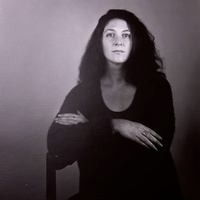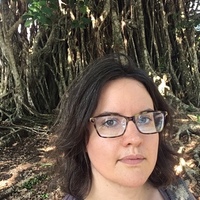
Yaëlle Biro
Yaëlle Biro joined the Metropolitan Museum of Art in 2007 and left this institution in December 2021 as Curator of African arts. She curated, co-curated a range of critically-acclaimed exhibitions, including Reconfiguring an African Icon: Odes to the Mask (2011); African Art, New York, and the Avant-Garde (2012); The Nelson A. Rockefeller Vision: In Pursuit of the Best in the Arts of Africa, Oceania, and the Americas (2013); In and Out of the Studio: Photographic Portraits in West Africa (2015); The Aftermath of Conflict: Jo Ractliffe’s Photographs of Angola and South Africa (2015); and The Face of Dynasty: Royal Crests from Western Cameroon
(2017). She also contributed extensively to exhibitions such as Eternal Ancestors: The Art of the Central African Reliquary (2007); The Essential Art of African Textiles: Design without End (2009); Heroic Africans: Legendary Leaders, Iconic Sculptures (2011); Warriors and Mothers: Epic Mbembe Art (2014); and Sahel: Art and Empires on the Shores of the Sahara (2020). Her exhibition African Art, New York, and the Avant-Garde focused on the reception of African art in America within the modernist context of the 1910s and 20s and received the 2012 Outstanding Small Exhibition Prize from the Association of American Museum Curators.
She completed her dissertation in 2010 at the Sorbonne in Paris on the mechanisms that led African objects to be seen as works of art in the West during the first decades of the twentieth century and was awarded the Dissertation Prize of the Musée du quai Branly for her work. Biro has contributed numerous essays in publications and exhibitions catalogues on topics connected to her interest in history of collecting African arts in the West, such as the genealogy of European and American exhibitions of
African arts before the 1930s, or the collecting and commercial activities of Joseph Brummer, Marius de Zayas, Charles Ratton, Tristan Tzara, Helena Rubinstein, or John Quinn. She has also written and organized conferences on the photographic representations of historical arts of Africa, especially by
Charles Sheeler and Paul Gebauer. The book based on her dissertation Fabriquer le regard: Marchands, réseaux, et objets d’art africain à l’aube du XXe siècle, was published with the French publishing house Les Presses du Réel in 2018. Her most recent publication is the edited volume Rhapsodic Objects: Art, Agency, and Materiality (1700-2000) co-edited with Noémie Etienne and published by De Gruyter (December 2021).
In addition to her curatorial work, Biro has lectured widely and given talks at academic institutions and museums in Africa, America, and Europe. She has served on the board of the Arts Council of the African Studies Association (ACASA); has chaired conference panels at CAA, ACASA, and ASA; has served on the Met’s Grants Committee, and has been called to review applications to fellowships for the Institute for Advanced Studies, Princeton and the Musée du quai Branly-Jacques Chirac. She has served as reviewer for Getty Publications, Afrique : Archeologie & Arts, the Art Bulletin, and CAA review.
(2017). She also contributed extensively to exhibitions such as Eternal Ancestors: The Art of the Central African Reliquary (2007); The Essential Art of African Textiles: Design without End (2009); Heroic Africans: Legendary Leaders, Iconic Sculptures (2011); Warriors and Mothers: Epic Mbembe Art (2014); and Sahel: Art and Empires on the Shores of the Sahara (2020). Her exhibition African Art, New York, and the Avant-Garde focused on the reception of African art in America within the modernist context of the 1910s and 20s and received the 2012 Outstanding Small Exhibition Prize from the Association of American Museum Curators.
She completed her dissertation in 2010 at the Sorbonne in Paris on the mechanisms that led African objects to be seen as works of art in the West during the first decades of the twentieth century and was awarded the Dissertation Prize of the Musée du quai Branly for her work. Biro has contributed numerous essays in publications and exhibitions catalogues on topics connected to her interest in history of collecting African arts in the West, such as the genealogy of European and American exhibitions of
African arts before the 1930s, or the collecting and commercial activities of Joseph Brummer, Marius de Zayas, Charles Ratton, Tristan Tzara, Helena Rubinstein, or John Quinn. She has also written and organized conferences on the photographic representations of historical arts of Africa, especially by
Charles Sheeler and Paul Gebauer. The book based on her dissertation Fabriquer le regard: Marchands, réseaux, et objets d’art africain à l’aube du XXe siècle, was published with the French publishing house Les Presses du Réel in 2018. Her most recent publication is the edited volume Rhapsodic Objects: Art, Agency, and Materiality (1700-2000) co-edited with Noémie Etienne and published by De Gruyter (December 2021).
In addition to her curatorial work, Biro has lectured widely and given talks at academic institutions and museums in Africa, America, and Europe. She has served on the board of the Arts Council of the African Studies Association (ACASA); has chaired conference panels at CAA, ACASA, and ASA; has served on the Met’s Grants Committee, and has been called to review applications to fellowships for the Institute for Advanced Studies, Princeton and the Musée du quai Branly-Jacques Chirac. She has served as reviewer for Getty Publications, Afrique : Archeologie & Arts, the Art Bulletin, and CAA review.
less
Related Authors
Noel B. Salazar
KU Leuven
Michael Birenbaum Quintero
Boston University
Alejandra B Osorio
Wellesley College
Oludamini Ogunnaike
University of Virginia
David Seamon
Kansas State University
Kate Cowcher
University of St Andrews
Paola D'Alconzo
Università degli Studi di Napoli "Federico II"
Armando Marques-Guedes
UNL - New University of Lisbon
Rachel E Smith
University of Aberdeen
Daniela Kern
Universidade Federal do Rio Grande do Sul
InterestsView All (28)










Uploads
Books by Yaëlle Biro
Edited Books by Yaëlle Biro
L'exposition se propose d'examiner les liens conceptuels et matériels existant entre le mouvement Surréaliste, son esthétique et sa vision du monde, et des œuvres d'Afrique, d'Océanie et des Amériques. Pour ce faire, nous souhaitons démontrer qu’il est possible de passer outre le récit suranné de la "découverte" et des “affinités esthétiques” qui continue à étayer les discours sur les rapports entre modernités occidentales et arts dits non-occidentaux. L’exposition à pour but de mettre les arts d’Afrique, d’Océanie, et des Amériques au centre du discours, par le biais de deux approches, l’une conceptuelle et l’autre ancrée dans des exemples concrets.
L’exposition suivra ces deux grands axes : le premier mettra en avant la centralité des rêves, du subconscient, et des mots dans les arts d'Afrique, d'Océanie, et d’Amérique tout en soulignant la manière dont cela fait écho aux préoccupations du mouvement surréaliste tels qu’André Breton le définit dans son Manifeste de 1924. Le second considérera l'engagement direct des Surréalistes avec ces arts, que ce soit en les publiant dans leurs revues, en les incluant dans des expositions, en y consacrant des écrits poétiques, ou encore par leurs pratiques collectionneuses et parfois marchande, – tout en abordant la manière dont ces activités s'inscrivent ou se mettent en porte-à-faux du contexte colonial de l’époque.
Suivant la définition faite des “ zones de contact ” par l’anthropologue Mary Louise Pratt (1991) comme des espaces sociaux de rencontres et de frictions culturelles, l'exposition offrira une approche ancrée historiquement et théoriquement, sur la dialectique des arts d'Océanie, des Amériques et d'Afrique, et du Surréalisme, pendant l'entre-deux-guerres. Notre but est de démontrer l’existence d’un ensemble de capillarité, alors même que Breton lui-même, en 1955, déclarait : “ L'inspiration que nous avons pu tirer de leur art est restée en définitive sans effet, faute d'un contact organique élémentaire, laissant une impression de déracinement" – et de placer les arts d'Afrique, d'Océanie et des Amériques au centre du récit et non pas comme une note en bas de page de l’histoire du Surréalisme. L'histoire ainsi ré-articulée est celle d'une relation complexe qui trouve sa source dans un nouvel ordre historique de l'art établi en Occident à une époque de profonds changements dans les pouvoirs mondiaux et à l'apogée de l'entreprise coloniale.
Citation : Biro, Yaëlle and Etienne, Noémie. Rhapsodic Objects: Art, Agency, and Materiality (1700–2000). Berlin, Boston: De Gruyter, 2021. https://doi.org/10.1515/9783110757668
Essays and Articles by Yaëlle Biro
contradictions at the turn of the twentieth century: on the one hand, the works were
admired for their technical mastery and the inherent value of their media; on the other, the narratives of imperial submission with which they were entangled left little room for sober appreciation.
L'exposition se propose d'examiner les liens conceptuels et matériels existant entre le mouvement Surréaliste, son esthétique et sa vision du monde, et des œuvres d'Afrique, d'Océanie et des Amériques. Pour ce faire, nous souhaitons démontrer qu’il est possible de passer outre le récit suranné de la "découverte" et des “affinités esthétiques” qui continue à étayer les discours sur les rapports entre modernités occidentales et arts dits non-occidentaux. L’exposition à pour but de mettre les arts d’Afrique, d’Océanie, et des Amériques au centre du discours, par le biais de deux approches, l’une conceptuelle et l’autre ancrée dans des exemples concrets.
L’exposition suivra ces deux grands axes : le premier mettra en avant la centralité des rêves, du subconscient, et des mots dans les arts d'Afrique, d'Océanie, et d’Amérique tout en soulignant la manière dont cela fait écho aux préoccupations du mouvement surréaliste tels qu’André Breton le définit dans son Manifeste de 1924. Le second considérera l'engagement direct des Surréalistes avec ces arts, que ce soit en les publiant dans leurs revues, en les incluant dans des expositions, en y consacrant des écrits poétiques, ou encore par leurs pratiques collectionneuses et parfois marchande, – tout en abordant la manière dont ces activités s'inscrivent ou se mettent en porte-à-faux du contexte colonial de l’époque.
Suivant la définition faite des “ zones de contact ” par l’anthropologue Mary Louise Pratt (1991) comme des espaces sociaux de rencontres et de frictions culturelles, l'exposition offrira une approche ancrée historiquement et théoriquement, sur la dialectique des arts d'Océanie, des Amériques et d'Afrique, et du Surréalisme, pendant l'entre-deux-guerres. Notre but est de démontrer l’existence d’un ensemble de capillarité, alors même que Breton lui-même, en 1955, déclarait : “ L'inspiration que nous avons pu tirer de leur art est restée en définitive sans effet, faute d'un contact organique élémentaire, laissant une impression de déracinement" – et de placer les arts d'Afrique, d'Océanie et des Amériques au centre du récit et non pas comme une note en bas de page de l’histoire du Surréalisme. L'histoire ainsi ré-articulée est celle d'une relation complexe qui trouve sa source dans un nouvel ordre historique de l'art établi en Occident à une époque de profonds changements dans les pouvoirs mondiaux et à l'apogée de l'entreprise coloniale.
Citation : Biro, Yaëlle and Etienne, Noémie. Rhapsodic Objects: Art, Agency, and Materiality (1700–2000). Berlin, Boston: De Gruyter, 2021. https://doi.org/10.1515/9783110757668
contradictions at the turn of the twentieth century: on the one hand, the works were
admired for their technical mastery and the inherent value of their media; on the other, the narratives of imperial submission with which they were entangled left little room for sober appreciation.
Part of the panel "The Materiality of Everyday Life in Africa: A Multi-Disciplinary Perspective (Part III)" organized by Abidemi B. Babalola (The British Museum) & Vera-Simone Schulz (Kunsthistorisches Institut in Florenz - Max-Planck-Institut), qt the 6th Lagos Studies Association Annual Conference, June 2022.
This panel seeks to deepen these important contributions, and expand the inquiry to other analysis bridging the histories of African sculpture and photography. How did photographic images overlap, replace or build onto the aesthetics of sculptural practices, whether earlier or contemporary? Have posing sessions in the photographic studio replicated postures commonly expressed in historical sculptures, or have their performative nature borrowed elements from African arts’ long traditions of performance? How relevant are historical forms in the photographic practice of contemporary artists? Lastly, how has the symbiotic relation between these two media contributed to shaping the field and the understanding of these traditions?
Chairs: Yaëlle Biro, Sandrine Colard, Giulia Paoletti
Panelists: Wendy Grossman; Lisa Aronson; Juliana Ribeiro da Silva Bevilacqua; Nanina Guyer; Romuald Tchibozo
In the 17th and 18th centuries, artists and craftspeople in Europe appropriated foreign techniques such as porcelain, textiles, or lacquers that eventually shaped local European identities. During the 19th century, Western consumers looked for genuine goods produced outside of industry, and the demand of Bourgeois tourism created a new market of authentic souvenirs and forgeries alike. Furthermore, the 20th century saw the (re)-emergence of local "Schools" of art and crafts as responses to political changes, anthropological research, and/or tourist demand. This multi-part conference will explore how technical knowledge, immaterial desires, and political agendas impacted the production and consumption of visual and material culture in different times and places. A new scrutiny of this back and forth between demanders and suppliers will allow us to map anew a multidirectional market for cultural goods in which the source countries could be positioned at the center.
This panel extends a conversation initiated through an ACASA-sponsored panel at the 2016 African Studies Association Annual Meeting in Washington DC. Following from that experience, this second gathering, in Accra, allows us to deepen engagement with the theme as well as bring different voices to the discussion. The goals remain the same, namely to question and shatter single stories in order to bring specificity to the study of historical arts of Africa. Panel participants will examine longstanding challenges in and fresh possibilities for the labeling and presentation of historical arts of Africa.
Co-Chairs: Susan Elizabeth Gagliardi, Emory University; Yaëlle Biro, The Metropolitan Museum of Art
Discussant: Constantine Petridis, Art Institute of Chicago
Speakers: John Warne Monroe, Iowa State University; Paul Davis, The Menil Collection; Matthew Rarey, Oberlin College; Elizabeth Perrill, UNC Greensboro
Attributing artistic creation and knowledge to discrete cultural or ethnic groups similarly conceals complexity, implying sameness among art makers, audiences, and patrons. Scholars have for decades recognized the inadequacy of the approach (e.g., Vandenhoute 1948, Sieber and Rubin 1968, Bravmann 1973, Kasfir 1984, Vogel 1984, Oguibe 1999, Berns, Fardon, and Kasfir 2011). Yet without new models to replace old frameworks, art historians and other scholars have continued to rely on singular cultural or ethnic group classifications to explain art. For example, on the basis of form, an encyclopedic museum, university museum, or other institution attributes a sculpture to the culture of the Senufo peoples, designates an object's maker as Senufo, or otherwise asserts the Senufo authorship of a work. Similar labeling applies to arts from across the continent. The approach roots analysis in bounded cultural or ethnic groups, insisting on single stories for artists, audiences, and patrons.
This panel seeks to question and shatter single stories in order to bring specificity to the study of historical arts of Africa. Panel participants examine longstanding challenges in and fresh possibilities for the labeling and presentation of historical arts of Africa to disparate audiences.
Co-Chairs: Susan Elizabeth Gagliardi, Emory University; Yaëlle Biro, The Metropolitan Museum of Art
Discussant: Kevin Dumouchelle, NMAfA
Panel speakers: Silvia Forni, Royal Ontario Museum; Kathryn Gunsch, Museum of Fine Arts, Boston; Matthew Francis Rarey, Assistant Professor, Oberlin College; Amanda Maples, PhD. Candidate, UC Santa Cruz
During the years that directly followed his death, the collection was dispersed through a series of public and private sales. Reentering the market, the works were propelled through unexpected journeys that revealed the co-existence of two parallel marketplaces: one where African objects were valued as works of art, and the other where the same works were considered as ethnographic documents. Eventually, some of Quinn’s artefacts continued to navigate the art world, while many others entered ethnographic museums – but not before their monetary value was significantly lowered. Based on extensive archival research, this paper proposes to investigate the physical and conceptual trajectories of some of these works – from the home of an important modern art collector where they neighbored works by Picasso and Brancusi, to the shelves of museums that favored ethnographic displays. It will also consider the moment when these two marketplaces collided, raising questions regarding the intrinsic value of things or its contextual relativity.
Frederick John Lamp, Curator Emeritus of African Art at the Yale Art Gallery
Christopher Steiner, Lucy C. McDannel ’22 Professor of Art History and Anthropology at Connecticut College
Yaëlle Biro, Associate Curator for the Arts of Africa at the Metropolitan Museum of Art
in conversation with Amanda Gilvin, Assistant Curator at the Davis.
Tout particulièrement, dès 1913, des expositions en Europe et aux Etats-Unis juxtaposèrent avec insistance sculptures africaines et œuvres de Picasso. De telles expositions non seulement révélèrent le discours nouvellement établit à la faveur d’une appréciation esthétique des arts de l’Afrique mais aussi, de par cette juxtaposition, mirent en avant le caractère radical du travail de Picasso. En prenant appui sur des documents d’archives en partie inédits, nous proposons de présenter le caractère systématique et international de ces juxtapositions en nous concentrant sur une décennie d’expositions : de la première exposition itinérante germanophone en 1913-14 « Picasso – Negerplastik » ; aux expérimentations d’Alfred Stieglitz et de Marius de Zayas à New York de 1914 à 1919 ; à l’exposition parisienne organisée par l’association Lyre et Palette en 1916 ; et en finissant par les expositions de Marius de Zayas et Charles Sheeler au Whitney Studio à New York de 1923-24, dont « Recent Paintings by Pablo Picasso and Negro Sculpture ».
Art History Open Session
New Approaches to the Study of Historical Arts in Africa
Sutton Parlor North, 2nd Floor
Chair: Susan Elizabeth Gagliardi, The City College, City University of New York
Unraveling the Foundation of African Arts in New York during the Modernist Era
Yaëlle Biro, The Metropolitan Museum of Art
When a Statue of a Colonial Agent Turns Out To Be a Pende Power Object: Joining Science, Field, and Archive
Richard B. Woodward, Virginia Museum of Fine Arts
A Muslim Masquerade in Southwestern Burkina Faso?
Lisa Homann, Wayne State University
Textiles as the Material of African Art History
Sarah C. Brett-Smith, Rutgers, The State University of New Jersey
Discussant: Steven Nelson, University of California, Los Angeles
"
https://www.metmuseum.org/blogs/collection-insights/2018/bongo-commemorative-post-ngya
As can be seen in many museum storage and gypsotheques, over centuries, plaster casts have been molded on art works, architectural elements, and even human beings. The Italian Renaissance and the 19th century are two contexts often discussed in the framing of the importance of casting as part of broader creative processes but their presence and impact goes beyond. Since the 1990s and the work by Georges Didi-Huberman (e.g. L’empreinte, 1997), plaster casts have stimulated art historical research and have expanded thinking about heritage.
In this volume edited by De Gruyter (New series Traces), we propose to redefine collectively what plaster casts are across different geographies and time periods, focusing mainly on the reproduction of objects. As the use of 3D printing of works of art is becoming common practice as a tool to the current debate on restitution of cultural patrimony, we would like to interrogate how this replication practice differs conceptually from the earlier one. We will explore what plaster casts were upon production and what they have become, what they enable, and how they impact original productions as well as discourses surrounding them.
Submit by August 6th
January 24th 2018: Workshop at La Colonie, Paris
February 21st 2018 : CAA 2-parts Session in Los Angeles
Organized by Yaëlle Biro, Metropolitan Museum of Art; and Noémie Étienne, Bern Universität (Visiting Professor at Université Paris 1 Panthéon-Sorbonne).
Circulation and imitation of cultural products are key factors in shaping the material world – as well as identities. Many objects or techniques that came to be seen as local, authentic, and typical are in fact entangled in complex transnational narratives tied to a history of imperialism, and the commercial phenomenon of supply and demand. In the 17th and 18th centuries, artists and craftspeople in Europe appropriated foreign techniques such as porcelain, textiles, or lacquers that eventually shaped local European identities. During the 19th century, Western consumers looked for genuine goods produced outside of industry, and the demand of Bourgeois tourism created a new market of authentic souvenirs and forgeries alike. Furthermore, the 20th century saw the (re)-emergence of local "Schools" of art and crafts as responses to political changes, anthropological research, and/or tourist demand. This multi-parts conference will explore how technical knowledge, immaterial desires, and political agendas impacted the production and consumption of visual and material culture in different times and places. A new scrutiny of this back and forth between demanders and suppliers will allow us to map anew a multidirectional market for cultural goods in which the source countries could be positioned at the center.